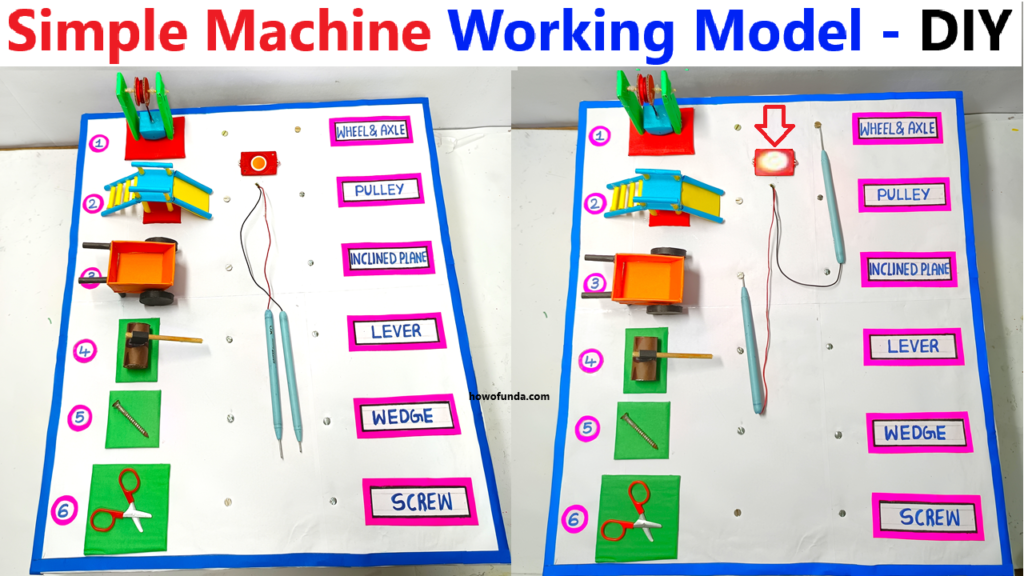Objective:
To create an interactive working model that explains simple machines (lever, pulley, inclined plane, etc.) using a match board concept powered by LED lights, a 9V battery, a buzzer, and conductive materials. The goal is to match the type of simple machine with its correct description or example.

Materials Required:
- Cardboard or wooden base (for the match board)
- LED lights (one for each correct match)
- 9V battery and battery clip
- Buzzer
- Nails or conductive pins
- Wires (for connections)
- Copper tape or conductive wire
- Labels for simple machines and their descriptions/examples
- Resistors (to protect LEDs)
- Glue, tape, and scissors
Steps to Build Simple Machine Working Model with Match Board Concept:
Prepare the Match Board:
- Divide the board into two sections:
- Left Side: Names of simple machines (e.g., Lever, Pulley, Inclined Plane, Wheel and Axle, Wedge, Screw).
- Right Side: Descriptions or examples of these machines (e.g., “Used to lift loads by applying force on one side”).
- Install Conductive Nails or Pins:
- Place nails or pins beneath each simple machine label on the left.
- Similarly, place nails or pins below each description or example on the right.
- Set Up the Circuit:
- For each correct pair (simple machine and its description/example):
- Connect a wire between the nails for the matching pair.
- Include an LED and a buzzer in the circuit.
- Use resistors to limit current for the LEDs.
- Connect the entire circuit to a 9V battery.
- For each correct pair (simple machine and its description/example):
- Ensure Unique Connections:
- Use separate circuits for each pair to ensure that only the correct match completes the circuit and activates the LED and buzzer.
- Test the Model:
- Verify that the LED lights up and the buzzer sounds only when a correct match is made.
How It Works:
Student Interaction:
- The student connects a wire or clip from a simple machine (on the left) to its correct description/example (on the right).
- Feedback:
- Correct Match: The LED lights up, and the buzzer sounds, indicating success.
- Incorrect Match: No response, encouraging the student to try again.
Examples for the Match Board:
- Lever:
- Description: “A rigid bar pivoted on a fulcrum to lift or move loads.”
- Example: See-saw or crowbar.
- Pulley:
- Description: “A wheel with a grooved rim used to lift heavy objects by pulling.”
- Example: Flagpole pulley.
- Inclined Plane:
- Description: “A slanted surface used to move heavy loads with less effort.”
- Example: Ramp.
- Wheel and Axle:
- Description: “A wheel attached to a central axle that rotates together to move objects.”
- Example: Rolling cart.
- Wedge:
- Description: “A device with a sloped surface used to split objects.”
- Example: Axe blade.
- Screw:
- Description: “An inclined plane wrapped around a shaft to hold objects together or lift.”
- Example: Jar lid.
This match board concept simplifies learning by combining physics principles with hands-on interaction, engaging both visual and auditory senses.

